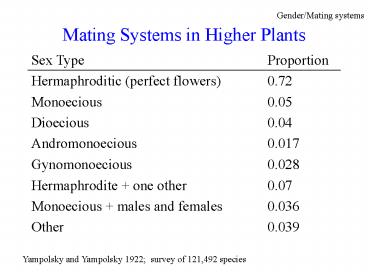Mating Systems in Higher Plants - PowerPoint PPT Presentation
1 / 32
Title:
Mating Systems in Higher Plants
Description:
With selfing, expect reduced male allocation due to local mate competition ... Weevil attack. Fruit remaining. Seed Dispersal. Why disperse? Escape hypothesis ... – PowerPoint PPT presentation
Number of Views:215
Avg rating:3.0/5.0
Title: Mating Systems in Higher Plants
1
Mating Systems in Higher Plants
Gender/Mating systems
Yampolsky and Yampolsky 1922 survey of 121,492
species
2
Monoecy
Gender/Mating systems
- Separate male and female flowers on the same
plant - Repro effort is partitioned in time and space,
selected for maximum efficiency (e.g. seed
production, seed dispersal, pollen donation) - Examples alder, pine, cucumber
3
Monoecy
Gender/Mating systems
- Arisaema triphyllum plants are sex changers
male when small or after fruit formation, female
when large
Bierzychudek 1984. Oecologia 6514-18
4
Dioecy
Gender/Mating systems
- Separate male and female plants
- Prevents selfing often see spatial segregation
due to differential mortality and nutrient
requirements (selection for separation of sexes?) - Examples indian plum, coconut, holly
5
Dioecy
Gender/Mating systems
- Large females (dotted) die more often than males
(dashed) juveniles (solid) also have high
mortality in Chamaelirium luteum
Mortality
Leaf number
Meagher and Antonovics 1982. Ecology 631690-1700
6
Dioecy
Gender/Mating systems
- Sex determination may be genetic (Silene
latifolia has a sex chromosome) or environmental
(some orchids if in sun, female)
7
Semelparity vs. Iteroparity
Timing of reproduction
- Semelparity monocarpy reproduce once and die
(big bang reproduction) - Iteroparity polycarpy reproduce repeatedly
prior to death
8
Semelparity vs. Iteroparity
Timing of reproduction
- Life history determined by fecundity and residual
reproductive value - Fecundity how does offspring production respond
to resource allocation? - Residual reproductive value how much resource
is left over to allow survival and another chance
of reproduction?
9
Semelparity
Timing of reproduction
Two optima all or none
10
Iteroparity
Timing of reproduction
Intermediate optimum
11
Semelparity vs. Iteroparity
Timing of reproduction
- What determines fecundity curve?
- Cost of reproduction (seeds, supporting
structures for inflorescence, etc.) may lead to
concave curve (semel) - Density dependent factors among offspring may
lead to convex curve (itero)
12
Semelparity vs. Iteroparity
Timing of reproduction
- What determines RRV curve?
- May differ among habitats, e.g. steeper decline
in marginal habitat (semel)
13
Dispersal
Seed Dispersal
- Seed size/number trade-offs
- Why disperse?
- Escape hypothesis
- Colonization hypothesis
14
Seed size/number trade-off
Seed Dispersal
- A general rule seed size and number trade off,
as resource pool is always finite - Predicted optimum for investment and offspring
fitness
Constant returns
Offspring success
Investment per offspring
15
Seed size/number trade-off
Seed Dispersal
- Seed size can affect survival, probability of
germination, early growth
16
Why disperse? Escape hypothesis
Seed Dispersal
- Mortality of seedlings highest near parent seed
predators, disease, sibling competition
17
Why disperse? Escape hypothesis
Seed Dispersal
- Datura seeds dispersed short distances (cm to m)
by ants - Seed predation by rodents on Datura greater under
parent plant than 1-3 meters away on ant middens,
or under different plant species
18
Why disperse? Escape hypothesis
Seed Dispersal
- In contrast, one way to make sure your offspring
escape is to swamp out seed predators
Plant fecundity
Fruit remaining
Weevil attack
19
Why disperse? Escape hypothesis
Seed Dispersal
- Masting a special case
20
Escape hypothesis
Seed Dispersal
- Masting a special case
- Panel a ponderosa pine and chalcid wasps
- Panel b ponderosa pine and abert squirrels
21
Why disperse? Colonization hypothesis
Seed Dispersal
- Particular habitats are required for
establishment - Applies especially to disturbed habitats,
unpredictable in time or space
22
Why disperse? Colonization hypothesis
Seed Dispersal
- Dispersal among islets near Bamfield Cody and
Overton 1996. J. Ecol. 8453-61 - Lactuca muralis (wall lettuce) weedy, wind
dispersed (pappus and achene)
23
Dispersal and morphology in Lactuca
Seed Dispersal
- Drop time longer when pappus volume/achene volume
( wing loading) was high (interpret?)
24
Problem 7
- Describe the general changes over time to Lactuca
propagules when plants colonize islets, as
compared to propagules of mainland plants. - What do you hypothesize was the selection
pressure for rapid evolution of propagule
morphology in island populations?
Population size
Achene volume
Pappus volume
Wing loading
Age after colonization of island
Mld mainland
25
Dispersal syndromes
Seed Dispersal
- Self gravity or explosive
- Abiotic wind, water
- In both cases, seeds are nondescript (brown or
green) wind dispersal selects for various
modifications
26
Dispersal syndromes
Seed Dispersal
- Insects
- Ant dispersed seeds have elaiosomes, oil-rich,
fleshy appendages
27
Dispersal syndromes
Seed Dispersal
- Vertebrate
- Nuts etc., buried and (sometimes) forgotten
- Attached, have hooks or spines
28
Dispersal syndromes
Seed Dispersal
- Vertebratemost common ingested
- Brightly colored, fleshy fruits
- Content of fruit often varies over season
species that produce fruits during peak bird
migration have higher lipid content - Advertisement may also vary over season
29
Dispersal syndromes
Seed Dispersal
- Fruit color may vary seasonally within communities
Burns Dalen. Oikos 96 463-469
30
Vertebrate dispersal
Seed Dispersal
- Why does salmonberry have two fruit colors?
- Birds prefer red morph in choice tests (Gervais
et al. Oikos 8477-86) - But
31
Invertebrate dispersal
Seed Dispersal
- Banana slugs suppress germination of red morph
(Gervais et al. Am Mid Nat 140103-110)
32
Summary Life history
- Pollination, dispersal, timing and amount of
repro all depend on interactions between biotic
and abiotic factors - We can predict life history adaptations by
analyzing selection pressures

